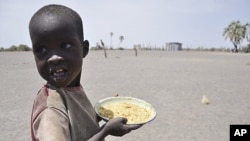In response to the ongoing crisis in the Horn of Africa, the World Bank is planning to provide Kenya with tens of millions of dollars to improve the country's defenses against future droughts.
The drought and famine currently rippling through east Africa has shown no signs of slowing. With governments, businesses and people around the world ramping up relief efforts, the World Bank has also decided to intervene.
A team of technical experts on emergency disaster recovery recently wrapped up a mission to assess the needs of the people and governments of East Africa. The team reviewed the humanitarian situation, the efforts to alleviate the situation, and the various drought prevention mechanisms already in place.
After concluding the mission, the World Bank has announced it will contribute $39 million to help fill gaps it found in the various drought and famine response efforts. Johannes Zutt is the World Bank Country Director for Kenya and Somalia.
"We have decided to do a few things: one is to provide some emergency financing to Somalia for the U.N. system to help support the livelihoods of Somalis in south-central Somalia," said Zutt. "We are also going to provide about $30 million to support the purchase of medical supplies and water supplies for the two refugee camps in Dolo Ado, Ethiopia and Dadaab, Kenya."
In addition to providing assistance to address region's immediate needs, the World Bank is looking at ways to improve the long-term livelihoods of people living in drought-prone areas, specifically in Kenya.
As part of their mission, the World Bank team visited Kenya's hardest-hit areas such as Turkana and parts of North Eastern Province. The team met with local residents as well as national and local government officials to determine what infrastructure existed to guard against drought.
The team concluded that shoring up existing water pipelines and reservoirs, improving environmental management systems, and improving rural infrastructure would provide effective shields against future natural disasters.
According to Zutt, the World Bank is also looking at ways to diversify and reform pastoralist community activities, to make them less vulnerable to drought.
"If you go up to places like Dadaab, to Mandera, you'll see that sheep and goats have eaten shoots of vegetation all the way down to the ground and that is resulting in expanding desertification," added Zutt. "What needs to happen is that animal populations need to be better controlled."
The World Bank hopes to contribute $87 million to these longer-term projects under its Crisis Response Window program. The $87 million is part of $250 million the World Bank hopes to deliver to the region for drought relief.
The Crisis Response Window program is subject to approval by the World Bank Board of Executive Directors, which is expected to reach a decision in September.
World Bank to Contribute Millions to Help Kenya Withstand Drought
















